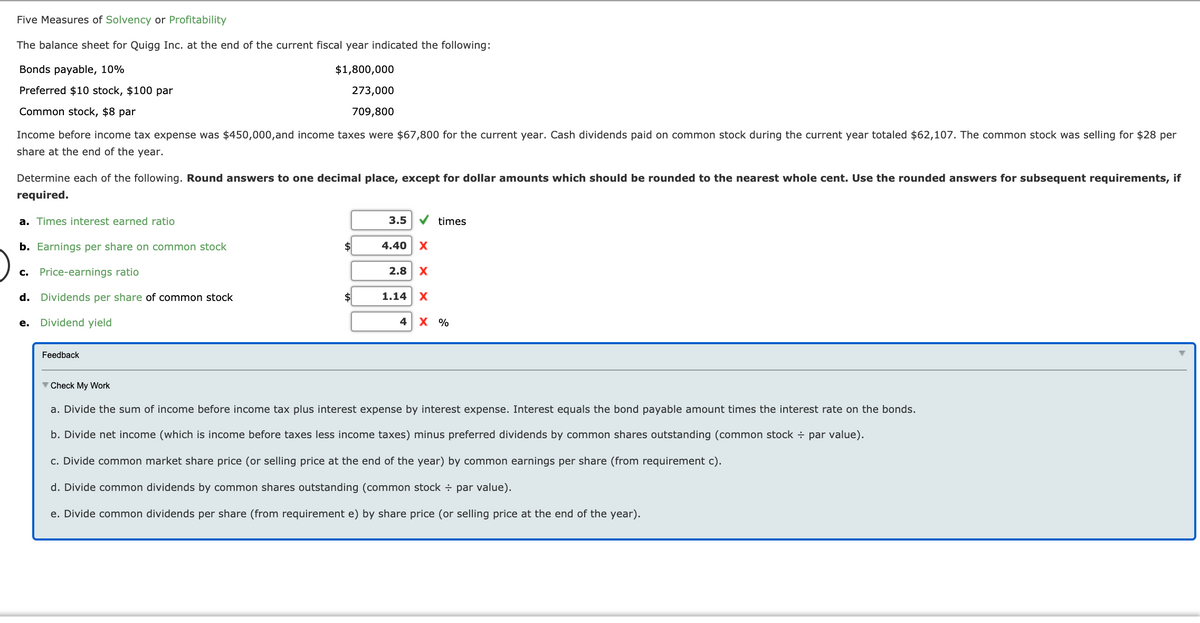Five Measures of Solvency or Profitability The balance sheet for Quigg Inc. at the end of the current fiscal year indicated the following: Bonds payable, 10% $1,800,000 Preferred $10 stock, $100 par 273,000 Common stock, $8 par 709,800 Income before income tax expense was $450,000,and income taxes were $67,800 for the current year. Cash dividends paid on common stock during the current year totaled $62,107. The common stock was selling for $28 pe share at the end of the year. Determine each of the following. Round answers to one decimal place, except for dollar amounts which should be rounded to the nearest whole cent. Use the rounded answers for subsequent requirements, required. a. Times interest earned ratio 3.5 v times b. Earnings per share on common stock 4.40 x c. Price-earnings ratio 2.8 x
Five Measures of Solvency or Profitability The balance sheet for Quigg Inc. at the end of the current fiscal year indicated the following: Bonds payable, 10% $1,800,000 Preferred $10 stock, $100 par 273,000 Common stock, $8 par 709,800 Income before income tax expense was $450,000,and income taxes were $67,800 for the current year. Cash dividends paid on common stock during the current year totaled $62,107. The common stock was selling for $28 pe share at the end of the year. Determine each of the following. Round answers to one decimal place, except for dollar amounts which should be rounded to the nearest whole cent. Use the rounded answers for subsequent requirements, required. a. Times interest earned ratio 3.5 v times b. Earnings per share on common stock 4.40 x c. Price-earnings ratio 2.8 x
Managerial Accounting
15th Edition
ISBN:9781337912020
Author:Carl Warren, Ph.d. Cma William B. Tayler
Publisher:Carl Warren, Ph.d. Cma William B. Tayler
Chapter16: Financial Statement Analysis
Section: Chapter Questions
Problem 20E
Related questions
Question

Transcribed Image Text:Five Measures of Solvency or Profitability
The balance sheet for Quigg Inc. at the end of the current fiscal year indicated the following:
Bonds payable, 10%
$1,800,000
Preferred $10 stock, $100 par
273,000
Common stock, $8 par
709,800
Income before income tax expense was $450,000,and income taxes were $67,800 for the current year. Cash dividends paid on common stock during the current year totaled $62,107. The common stock was selling for $28 per
share at the end of the year.
Determine each of the following. Round answers to one decimal place, except for dollar amounts which should be rounded to the nearest whole cent. Use the rounded answers for subsequent requirements, if
required.
a. Times interest earned ratio
3.5
times
b. Earnings per share on common stock
2$
4.40
X
c. Price-earnings ratio
2.8
X
d. Dividends per share of common stock
$
1.14
Dividend yield
4 х %
е.
Feedback
V Check My Work
a. Divide the sum of income before income tax plus interest expense by interest expense. Interest equals the bond payable amount times the interest rate on the bonds.
b. Divide net income (which is income before taxes less income taxes) minus preferred dividends by common shares outstanding (common stock ÷ par value).
c. Divide
market share price (or selling price at the end of the year) by
earnings per share (from requirement c).
d. Divide common dividends by common shares outstanding (common stock ÷ par value).
e. Divide common dividends per share (from requirement e) by share price (or selling price at the end of the year).
Expert Solution
This question has been solved!
Explore an expertly crafted, step-by-step solution for a thorough understanding of key concepts.
Step by step
Solved in 3 steps

Knowledge Booster
Learn more about
Need a deep-dive on the concept behind this application? Look no further. Learn more about this topic, accounting and related others by exploring similar questions and additional content below.Recommended textbooks for you

Managerial Accounting
Accounting
ISBN:
9781337912020
Author:
Carl Warren, Ph.d. Cma William B. Tayler
Publisher:
South-Western College Pub

Financial And Managerial Accounting
Accounting
ISBN:
9781337902663
Author:
WARREN, Carl S.
Publisher:
Cengage Learning,

Financial Accounting
Accounting
ISBN:
9781337272124
Author:
Carl Warren, James M. Reeve, Jonathan Duchac
Publisher:
Cengage Learning

Managerial Accounting
Accounting
ISBN:
9781337912020
Author:
Carl Warren, Ph.d. Cma William B. Tayler
Publisher:
South-Western College Pub

Financial And Managerial Accounting
Accounting
ISBN:
9781337902663
Author:
WARREN, Carl S.
Publisher:
Cengage Learning,

Financial Accounting
Accounting
ISBN:
9781337272124
Author:
Carl Warren, James M. Reeve, Jonathan Duchac
Publisher:
Cengage Learning

College Accounting, Chapters 1-27
Accounting
ISBN:
9781337794756
Author:
HEINTZ, James A.
Publisher:
Cengage Learning,

Managerial Accounting: The Cornerstone of Busines…
Accounting
ISBN:
9781337115773
Author:
Maryanne M. Mowen, Don R. Hansen, Dan L. Heitger
Publisher:
Cengage Learning

Intermediate Accounting: Reporting And Analysis
Accounting
ISBN:
9781337788281
Author:
James M. Wahlen, Jefferson P. Jones, Donald Pagach
Publisher:
Cengage Learning